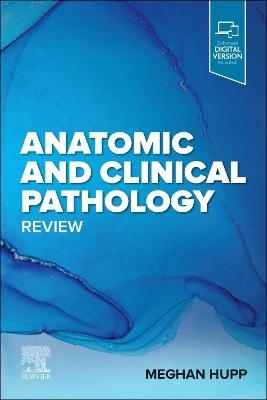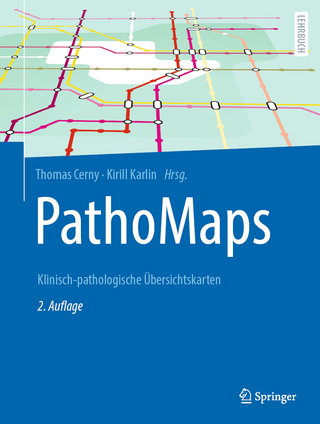
Anatomic and Clinical Pathology Review
Elsevier - Health Sciences Division (Verlag)
978-0-323-87113-6 (ISBN)
Distills the essential information needed to prepare for both the Anatomic and Clinical Pathology board exams in an easy-to-read outline format.
Provides high-yield, at-a-glance summaries in quick reference format for all topics that are encountered by pathology residents and practitioners in the boards.
Uses brief, to-the-point explanatory text to make key facts easier to memorize.
Incorporates current molecular and serologic tumor markers, techniques, and findings as appropriate.
Features numerous high-quality illustrations that provide a visual guide to histologic appearance of key entities.
Ideal for junior residents as a framework for rotations through the subspecialties, for senior residents and fellows to prepare for boards and their future practice, and for newly practicing pathologists.
Enhanced eBook version included with purchase. Your enhanced eBook allows you to access all of the text, figures, and references from the book on a variety of devices.
Dr Meghan Hupp is a Fellow in Hematopathology at the University of Minnesota. She was the Chief Resident in the Pathology Department and put together this ms "as a result of my unending need to take notes and re-organize data in my mind as I rotated through the different subspecialties Dr Hupp's program director, Dr Leo Furcht, recommended that we take a look at her ms to consider for publication.
1. General pathology - mechanistic approach to pathology, general pathobiology, amyloidosis, congenital syndromes, tumor genetics, microscopy tutorial
2. General anatomic pathology - PD-1 and PD-L1, neoplasms of unknown origin, normal immunophenotypes, special stains, rosettes and pseudorosettes, giant cell types, small round blue cell tumors, gross pathology
3. Breast pathology - basic pathology, gene expression profiles, ductal neoplasia, lobular neoplasia, columnar lessions, papillary lesions, other malignant tumors, radiologically suspicious lesions, benign breast pathology, fibrous and fibroepithelial lesions, treatment, molecular/cytogenetics, images and charts
4. Dermatopathology - definitions and associations, congenital/inherited conditions, inflammatory patterns, hair loss, infectious, lichen/lichenoid lesions, blistering disorders, vascular disorders and vasculitis, other inflammatory conditions, follicular/adnexal neoplasms, squamous and warty lesions, pigmented lesions, vascular neoplasms, hematolymphoid neoplasms, miscellaneous neoplasms
5. Gynecologic pathology - vagina and vulva, non-neoplastic cervix, neoplastic cervix, non-neoplastic uterus, endometrial hyperplasia and atypia, endometrial carcinoma, uterine mesenchymal tumors, ovarian surface epithelial neoplasms, ovarian sex cord-stromal neoplasms, ovarian germ cell tumors
6. Placentas and products of conception - products of conception and normal anatomy/physiology, molar pregnancies, placental infections/inflammation, gestational trophoblastic disease, placental neoplasms
7. Pediatric pathology - metabolic disorders, pediatric renal neoplasms, pediatric gastrointestinal, soft tissue neoplasms, genitourinary, neural and musculoskeletal
8. Gastrointestinal (and pancreas) pathology - syndromes, esophagus, stomach, small intestine, colon and rectum, appendix, anus, pancreas, gallbladder and biliary trees, GI lymphomas
9. Liver pathology - basic medical liver, laboratory values, hepatitis disorders, cholestatic disorders, vascular, transplant, congenital, benign neoplasms, malignant neoplasms
10. Genitourinary pathology - prostate normal histology and anatomy, adenocarcinoma and mimickers, non-neoplastic testis, testicular germ cell neoplasms, testicular sex cord-stromal neoplasms, adrenal pathology, bladder anatomy and histology, urothelial neoplasms, other bladder neoplasms, non-neoplastic bladder, penile pathology, non-neoplastic kidney, renal-cell carcinoma and related neoplasms, other neoplasms
11. Medical renal - donor kidney evaluation, glomerular disease, tubulointerstitial and vascular disease, congenital syndromes and lesions, transplant pathology
12. Forensics pathology - introduction, toxicology and chemistry, sharp and blunt force injuries, asphyxia, pathology of child abuse deaths, sleep related deaths and airway obstruction
13. Lung and cardiac pathology - non-neoplastic lung (medical and transplant), neoplastic lung (benign and malignant), lung odds and ends, cardiac pathology
14. Head and neck pathology - normal salivary gland, neoplastic salivary gland, normal sinonasal, neoplastic sinonasal, oropharyngeal and laryngeal squamous neoplasia, thyroid, mandibular/maxillary lesions
15. Neuropathology - anatomy and physiology, glial tumors, neurocytic tumors, glioneuronal tumors, pineal tumors, pediatric tumors, pathologic reactions of the nervous system, CNS vascular disease, myelin diseases, trauma, dementias and movement disorders, infections
16. Soft tissue pathology - adipocytic lesions, neural lesions, smooth muscle lesions, skeletal muscle lesions, fibrohistiocytic lesions, osteoblastic lesions, cartilaginous lesions, vascular lesions, unknown origin, other neoplasms, small round blue cell tumors, non-neoplastic, genetics
17. Cytopathology - basics, gynecologic, head and neck, lung and mediastinum, thyroid, pancreas, urine, body fluids, CSF, infectious, lab management, molecular, breast, liver
18. Chemistry and lab management - protein electrophoresis, cardiac biomarkers, electrolytes, liver and renal function tests, tumor markers, vitamins, endocrine, lipids, reproduction and fertility, cryoglobulins, pleural effusions, toxicology, clinical lab improvement act (CLIA) '88, lab automation and instrument selection, method validation, pediatric lab medicine, metrics, directing a clinical laboratory, equations
19. Genetics in pathology - basic molecular and cellular biology, methods, human genetic variation, tumor syndromes, hematolymphoid neoplasms, solid tumors, hereditary non-neoplastic disease, pharmacogenetics
20. Immunology - cellular basis of immunology, autoimmune clinical syndromes, immunodeficiency disorders, other clinical syndromes/disorders, human leukocyte antigen system
21. Coagulation - coagulation cascade, anticoagulants, coagulation assays, disorders of primary hemostasis, von Willebrand disease, heparin-induced thrombocytopenia, factor testing, thrombophilia
22. Transfusion medicine - laboratory methods, blood products, antigens and antibodies, apheresis, transfusion reactions, transfusion-related coagulation topics, donor selection
23. Hematopathology - evaluating bone marrow, immunophenotypes, flow cytometry, inherited WBC disorders, erythrocyte abnormalities, reactive lymphadenopathy, hematolymphoid manifestations of systemic disease, infectious, histiocytic/functional disorders, myeloproliferative neoplasms, mastocytosis, myelodysplastic syndromes, MDS/MPN, acute myeloid leukemia, B cell chronic lymphoproliferative neoplasms, Hodgkin lymphoma, plasma cell neoplasms, T and NK cell chronic lymphoproliferative neoplasms, lymphoblastic leukemia/lymphoma (B and T cell), genetics, pitfalls
24. Microbiology - basics, materials and methods, bioterrorism, bacterial identification algorithms, bacterial metabolism, gram positive, gram negative, mycobacteria, weirdo bacteria, bacterial clinical syndromes, fungi basics, superficial fungi, endemic fungi, opportunistic fungi, protozoa, helminths, trematodes, cestodes, nematodes, vectors, RNA viruses, DNA viruses, antibiotic mechanisms of action, mechanisms of antimicrobial resistance, MALDI-TOF-MS
1. General pathology - mechanistic approach to pathology, general pathobiology, amyloidosis, congenital syndromes, tumor genetics, microscopy tutorial
2. General anatomic pathology - PD-1 and PD-L1, neoplasms of unknown origin, normal immunophenotypes, special stains, rosettes and pseudorosettes, giant cell types, small round blue cell tumors, gross pathology
3. Breast pathology - basic pathology, gene expression profiles, ductal neoplasia, lobular neoplasia, columnar lessions, papillary lesions, other malignant tumors, radiologically suspicious lesions, benign breast pathology, fibrous and fibroepithelial lesions, treatment, molecular/cytogenetics, images and charts
4. Dermatopathology - definitions and associations, congenital/inherited conditions, inflammatory patterns, hair loss, infectious, lichen/lichenoid lesions, blistering disorders, vascular disorders and vasculitis, other inflammatory conditions, follicular/adnexal neoplasms, squamous and warty lesions, pigmented lesions, vascular neoplasms, hematolymphoid neoplasms, miscellaneous neoplasms
5. Gynecologic pathology - vagina and vulva, non-neoplastic cervix, neoplastic cervix, non-neoplastic uterus, endometrial hyperplasia and atypia, endometrial carcinoma, uterine mesenchymal tumors, ovarian surface epithelial neoplasms, ovarian sex cord-stromal neoplasms, ovarian germ cell tumors
6. Placentas and products of conception - products of conception and normal anatomy/physiology, molar pregnancies, placental infections/inflammation, gestational trophoblastic disease, placental neoplasms
7. Pediatric pathology - metabolic disorders, pediatric renal neoplasms, pediatric gastrointestinal, soft tissue neoplasms, genitourinary, neural and musculoskeletal
8. Gastrointestinal (and pancreas) pathology - syndromes, esophagus, stomach, small intestine, colon and rectum, appendix, anus, pancreas, gallbladder and biliary trees, GI lymphomas
9. Liver pathology - basic medical liver, laboratory values, hepatitis disorders, cholestatic disorders, vascular, transplant, congenital, benign neoplasms, malignant neoplasms
10. Genitourinary pathology - prostate normal histology and anatomy, adenocarcinoma and mimickers, non-neoplastic testis, testicular germ cell neoplasms, testicular sex cord-stromal neoplasms, adrenal pathology, bladder anatomy and histology, urothelial neoplasms, other bladder neoplasms, non-neoplastic bladder, penile pathology, non-neoplastic kidney, renal-cell carcinoma and related neoplasms, other neoplasms
11. Medical renal - donor kidney evaluation, glomerular disease, tubulointerstitial and vascular disease, congenital syndromes and lesions, transplant pathology
12. Forensics pathology - introduction, toxicology and chemistry, sharp and blunt force injuries, asphyxia, pathology of child abuse deaths, sleep related deaths and airway obstruction
13. Lung and cardiac pathology - non-neoplastic lung (medical and transplant), neoplastic lung (benign and malignant), lung odds and ends, cardiac pathology
14. Head and neck pathology - normal salivary gland, neoplastic salivary gland, normal sinonasal, neoplastic sinonasal, oropharyngeal and laryngeal squamous neoplasia, thyroid, mandibular/maxillary lesions
15. Neuropathology - anatomy and physiology, glial tumors, neurocytic tumors, glioneuronal tumors, pineal tumors, pediatric tumors, pathologic reactions of the nervous system, CNS vascular disease, myelin diseases, trauma, dementias and movement disorders, infections
16. Soft tissue pathology - adipocytic lesions, neural lesions, smooth muscle lesions, skeletal muscle lesions, fibrohistiocytic lesions, osteoblastic lesions, cartilaginous lesions, vascular lesions, unknown origin, other neoplasms, small round blue cell tumors, non-neoplastic, genetics
17. Cytopathology - basics, gynecologic, head and neck, lung and mediastinum, thyroid, pancreas, urine, body fluids, CSF, infectious, lab management, molecular, breast, liver
18. Chemistry and lab management - protein electrophoresis, cardiac biomarkers, electrolytes, liver and renal function tests, tumor markers, vitamins, endocrine, lipids, reproduction and fertility, cryoglobulins, pleural effusions, toxicology, clinical lab improvement act (CLIA) '88, lab automation and instrument selection, method validation, pediatric lab medicine, metrics, directing a clinical laboratory, equations
19. Genetics in pathology - basic molecular and cellular biology, methods, human genetic variation, tumor syndromes, hematolymphoid neoplasms, solid tumors, hereditary non-neoplastic disease, pharmacogenetics
20. Immunology - cellular basis of immunology, autoimmune clinical syndromes, immunodeficiency disorders, other clinical syndromes/disorders, human leukocyte antigen system
21. Coagulation - coagulation cascade, anticoagulants, coagulation assays, disorders of primary hemostasis, von Willebrand disease, heparin-induced thrombocytopenia, factor testing, thrombophilia
22. Transfusion medicine - laboratory methods, blood products, antigens and antibodies, apheresis, transfusion reactions, transfusion-related coagulation topics, donor selection
23. Hematopathology - evaluating bone marrow, immunophenotypes, flow cytometry, inherited WBC disorders, erythrocyte abnormalities, reactive lymphadenopathy, hematolymphoid manifestations of systemic disease, infectious, histiocytic/functional disorders, myeloproliferative neoplasms, mastocytosis, myelodysplastic syndromes, MDS/MPN, acute myeloid leukemia, B cell chronic lymphoproliferative neoplasms, Hodgkin lymphoma, plasma cell neoplasms, T and NK cell chronic lymphoproliferative neoplasms, lymphoblastic leukemia/lymphoma (B and T cell), genetics, pitfalls
24. Microbiology - basics, materials and methods, bioterrorism, bacterial identification algorithms, bacterial metabolism, gram positive, gram negative, mycobacteria, weirdo bacteria, bacterial clinical syndromes, fungi basics, superficial fungi, endemic fungi, opportunistic fungi, protozoa, helminths, trematodes, cestodes, nematodes, vectors, RNA viruses, DNA viruses, antibiotic mechanisms of action, mechanisms of antimicrobial resistance, MALDI-TOF-MS
| Erscheinungsdatum | 17.08.2022 |
|---|---|
| Verlagsort | Philadelphia |
| Sprache | englisch |
| Maße | 152 x 229 mm |
| Gewicht | 1000 g |
| Themenwelt | Studium ► 2. Studienabschnitt (Klinik) ► Pathologie |
| ISBN-10 | 0-323-87113-5 / 0323871135 |
| ISBN-13 | 978-0-323-87113-6 / 9780323871136 |
| Zustand | Neuware |
| Informationen gemäß Produktsicherheitsverordnung (GPSR) | |
| Haben Sie eine Frage zum Produkt? |
aus dem Bereich


